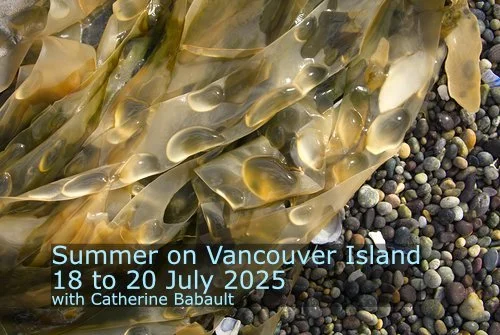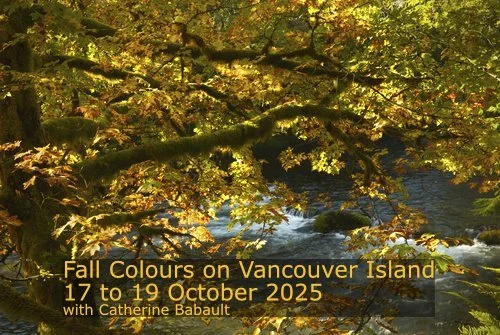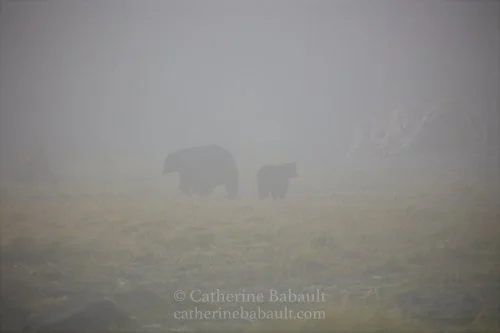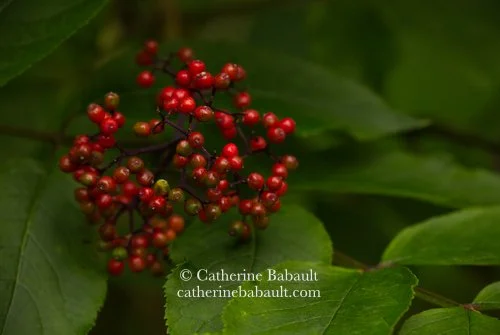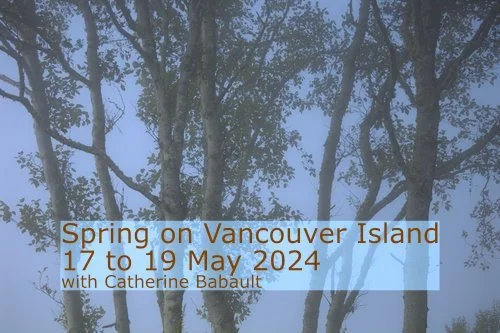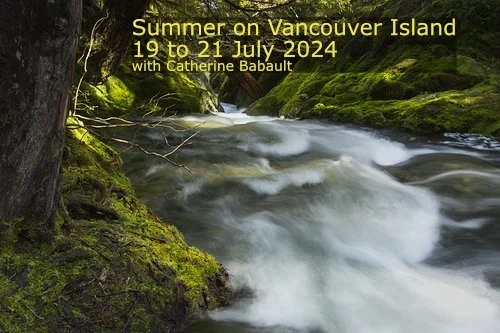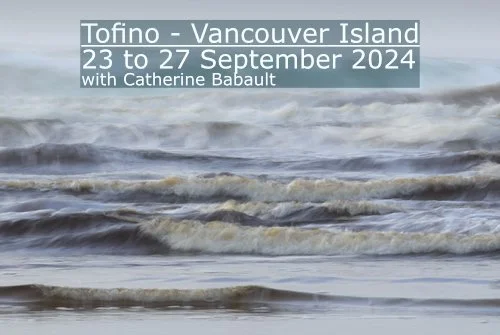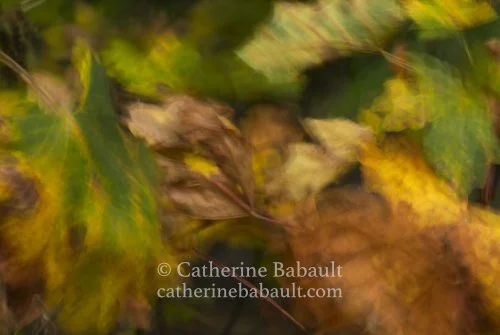Unique photo opportunities to capture black bears catching salmon, Roosevelt elk herds during the rutting period, and sea lions gatherings to feed along the coast.
Vancouver Island is a stopover on the Pacific Flyway whereas some birds choose to winter on the island such as trumpeter swan, long-tailed duck and surf scoter.
Lower light conditions are better for nature photography.
Fall is a display of vibrant colours in the rainforest while winter offers misty landscapes and waves crashing on the rugged shoreline during storms.
The shoulder season is a great time to enjoy the tranquility in the forest and take the time to create your best images. It is also cheaper to travel.
New Vancouver Island Photo Tours
I am delighted to announce new group tours this summer!
The long days of summer provide plenty of time to go outside and explore the coastal rainforests and shorelines of Vancouver Island. Join me for a tour in the greater region of the Comox Valley. We'll depart early in the morning from Courtenay to take advantage of the light. We'll visit beautiful locations where we could see many species of birds, river otters, black-tailed deer, seals and black bears. Each tour lasts about 8 hours. They are limited to 3 persons plus me, your host, in order to reduce our impact on the environment and wildlife, and for a better learning experience.
Group photo tours available on June 3, 11, 19, 27, July 5, 9, 22, 31, and August 9 and 15. Learn more…
If you prefer, you can book a private photo tour or workshop at a different time.
Review: ‘‘We (a couple) booked Catherine for two days to take us to some beautiful photography locations on Vancouver Island, including both landscapes and wildlife. We had two amazing days. Catherine is a true professional, with extensive knowledge of nature and wildlife. She is also very respectful of animals and takes care not to disturb them, which we greatly appreciated. She gave us helpful tips for the rest of our stay on the island as well. In addition to being an excellent guide, Catherine is a wonderful person to spend time with, and we thoroughly enjoyed her company. We can highly recommend her to anyone looking to get more out of their photography experience on Vancouver Island.’’ Irma from the Netherlands
When to use a polarizing filter
A polarizing filter is used to reduce reflections and glare from surfaces such as water or glass. Reflections are almost everywhere in nature: light bouncing off wet leaves or rocks surrounding waterfalls. In addition, a polarizing filter increases colour saturation, darken skies and reduces atmospheric haze.
The disadvantage of a polarizing filter is the loss of light that comes through your lens. I recommend a high quality circular polarizing filter to reduce the loss of light between 1 and 1.5 stop. You can compensate that loss by reducing the shutter speed, using a bigger aperture or increasing the ISO. Make sure that both your lens and polarizing filter are clean and free of dust.
These photos demonstrate what a polarizing filter can do when the light bounces off the surface of wet leaves. Note that I used a telephoto lens to isolate my subject and a short depth of field to blur the background.
Black Bear Signs on Vancouver Island, BC
When photographing wildlife, I am always aware of my surroundings. I pay attention to sounds, animal calls, tracks, droppings, and any sign that indicates the presence of wildlife.
A few weeks ago, while on a solo trip to photograph bears in an isolated area, I was distracted by a beautiful Savannah sparrow foraging on the beach. The bird was getting close to me so I used a large piece of driftwood to lean over and take photos at eye-level. I was quiet and still so as not to startle the sparrow. After getting a few good shots, I stood up and that's when I heard a commotion right behind me. It sounded like someone or something heavy had tumbled over a big log. I quickly turned around and saw the back of a black bear in the thick bushes. He was about five metres away from me. The panicked bear started running into the bushes as fast as he could. I could follow his direction by the movements in the bushes. At one point, he even bumped into a small tree. Unlike the bear, I was very calm and the situation actually made me smile. Obviously he hadn't noticed my presence until I moved. But it was also a good reminder to me that I can be very close to wildlife without even realizing it. So I'd like to share with you some basic information and signs of black bears.
On Vancouver Island, black bears inhabit forests, grasslands, meadows, intertidal zones, estuaries, river shorelines and urban areas. They eat a wide range of food such as plants, berries, insects, clams, crabs, and fish. Bears are plantigrade, which means they walk on the soles of their feet like humans. The print of their hind foot looks like that of humans. They have five toes like us. These photos show a few signs that you are in bear land: a partially eaten salmon, old scratches on a tree, tracks in the sand, and sandy prints of a front foot next to a hind foot on a wet log.
Stay safe!
Vancouver Island Photo Tours and Workshops in 2025
I offer photo tours and workshops on Vancouver Island all year round since 2018, in English and French. I had the pleasure to meet amateur and professional photographers from North America, South America, Europe and Australia. I'd love to show you some of my favourite places on Vancouver Island for nature and wildlife photography. I offer both group tours/workshops and private tours/workshops all year round. Contact me for more information.
Private nature photography tours and workshops
Contact me if you would like to book a private tour or workshop on Vancouver Island. I am more than happy to prepare a customized itinerary based on your interests and experience in photography. The private tours and workshops range from half a day to a full day or several days.
Group photo workshops in the field for 2025
Herring Spawn on Vancouver Island - Daily photo workshops during the herring spawn. This spectacular annual event attracts a lot of wildlife on our shore. If you are a keen wildlife photographer, this workshop is for you. We could see sea lions, seals, whales from the shore, minks, river otters, many many bird species such as bald eagles and great blue herons. Avoid seasickness on a boat tour and enjoy nature from land! Limited to 3 people per workshop. Sign up early.
Vancouver Island Photo Tour for Women in May - Join fellow women photographers on this unique journey in Vancouver Island, British Columbia, a region known for its great biodiversity. It is home to the coastal black bears, wolves, Roosevelt elks, bald eagles, river otters, sea lions, minks, and many bird and mammal species. Explore the temperate rainforest with its moss-covered trees, giant cedar and Douglas fir. Limited to 3 participants. Learn more.
Spring on Vancouver Island - Spring is a time of migration for thousands of birds and mammals on the island. During this three-day workshop, we will visit the shore, estuaries and forests with moss-covered trees where we could see a variety of wildlife such as owls, bald eagles, beavers, black-tailed deers, seals, sea lions, river otters and many other species. Sign up today.
Summer on Vancouver Island - The long days of summer provide plenty of time to go outside and explore the coastal rainforests and shore on the island. Wildlife is busy caring for their young and protecting their territory in the lush rainforest and on the coast. Limited to 3 participants, sign up today.
Vancouver Island Photo Tour for Women in September - Join fellow women photographers on this unique journey in Vancouver Island, British Columbia, a region known for its great biodiversity. It is home to the coastal black bears, wolves, Roosevelt elks, bald eagles, river otters, sea lions, minks, and many bird and mammal species. Explore the temperate rainforest with its moss-covered trees, giant cedar and Douglas fir. Limited to 3 participants. Learn more.
Fall on Vancouver Island - Fall is an exciting time for photographers and wildlife. Many birds pass through the region on route to their winter grounds or make Vancouver Island their temporary home. The salmon returns to its native springs to spawn and black bears take advantage of it to fatten up for winter. Meanwhile deciduous trees in the lush forests turn yellow, orange and red to the delight of photographers. This is a popular workshop and it is limited to 3 participants, sign up early.
Composing with light
Wildlife photographers are familiar with two unpredictable elements: wild animals' behaviour and light. On Vancouver Island it can rain, be foggy and sunny on the same day therefore the light varies all the time. No matter what type of light, harsh or soft, I have to adapt and be creative. Over the years, I have photographed black bears in all kinds of weather conditions and these are some photos to illustrate how I used the light.
Bright sunny day
Harsh light on a sunny day creates strong contrast between shadow and light. Details are lost in dark shadows and bright spots. Furthermore bright spots attract the eyes of the viewer so I take that into consideration when I frame my subject. Light can also bounce off shiny surfaces such as water and leaves, and for this reason I use a polarizing filter to suppress the glare.
Black bear on a sunny day. Photo taken with a polarizing filter.
Black bear on a bright sunrise. Photo taken without a polarizing filter.
Overcast day
Soft light on a cloudy day means less contrast between shadow and light. The viewer's eyes are attracted by the details in the fur of the black bear, its brown snout, its beady eyes and the scales of the fish. This is my prefered type of light.
Black bear on an overcast day.
Black bear with a salmon on an overcast day.
Shooting in thick fog
One morning, I found myself surrounded by black bears in thick fog. The only way to differentiate between rounded boulders and fatty black bears was when the large dark mass started to move. Instead of putting my camera down and waiting for the fog to dissipate, which could take a long time, I used the fog to capture the mood of that moment.
Black bear in thick fog.
Female black bear and her cub in thick fog.
Silhouettes
A backlit subject, or a dark subject against a bright background, can produce interesting silhouettes and create bold images. The subject really stands out.
Silhouette of a black bear walking on the shore.
Silhouette of a black bear eating a salmon in the sea.
No matter what type of light, there are ways to adapt and be creative.
How did I create this image
Participants to my photo workshops often ask me about my thought process when I shoot. In this case the first thing I noticed, while walking in the forest, were the red berries and green foliage. When we look at a photograph or a painting, our eyes are unconsciously attracted to elements in red in the overall composition. In addition, red and green are opposite to each other in the wheel of colour, they are complementary colours like blue and orange, and yellow and violet. The use of complementary colours in photography creates a bold image.
My next step consisted of framing my subject so I moved around it to find the best angle. Should I look down, look up, be at eye-level, where is the light coming from? I also took into consideration distracting elements such as bright areas, leading lines, branches, damaged foliage, etc. I chose a telephoto lens to isolate my subject and I used a tripod for stability. Next I thought about the mood of my image and determined the depth of field, aperture and shutter speed. I chose to underexpose by one full stop. I also used a polarizing filter to suppress the reflection of light on the shiny surface of the berries.
In conclusion, I prefer to take my time in the field than spending hours in front of my computer screen trying to fix my mistakes. Afterall I love nature much more than my computer!
If you would like to learn more about my photo workshops, please contact me. I will be more than happy to help you hone your skills in nature and wildlife photography.
Photographing the coastal black bear
As a wildlife photographer, I enjoy learning about wild animals and observing them in their natural environment. While some photographers are interested in birds, I prefer mammals. Big mammals, like bears. Their large size, curvy shape and thick fur make them both attractive and intimidating.
I saw my first black bear in Manitoba during a solo road-trip across the country. I was driving on a rural road when suddenly a chunky bear crossed the road and dashed into the woods. It was a brief encounter but I was delighted. After settling on Vancouver Island, I became aware that bears are everywhere. They frequent the mountains, coastal rainforests and towns. I also learnt that black bears can swim, climb trees, and break into homes and vehicles. I had moved to bear country.
After learning about bear safety, my next step was to capture their natural behaviour in their natural habitat. However, I had to find the right balance between reaching my goal and minimizing my impact on the animals, which meant I had to keep a safe distance and avoid disrupting their activities. The other factors I had to consider were the location and accessibility, the time of the year, the light, and the setting. After spending an extensive period of time researching at home and exploring in the field, I found a remote prime fishing spot used by black bears during the salmon run. By the time I first visited that spot, I had encountered many black bears around Vancouver Island, so I was familiar with their behaviour and I knew how to read their body language.
Mama bear and her cub on a foggy morning, Vancouver Island, British Columbia.
One morning, when I arrived at that fishing spot, it was entirely wrapped in thick fog and the visibility was greatly reduced. I could see dark rounded shapes here and there on the shoreline, but I could only determine whether it was a bear or a big boulder when it started to move. It was a surreal experience. One by one, bears came out of the rainforest and nonchalantly walked to a pool of water filled with salmon. Once they caught a fish, they walked back to the forest where they ate their tasty meal in peace. They mostly came alone but sometimes a mother bear was accompanied by her cubs. The time passed slowly as I waited for them to appear and disappear through the dense fog. I felt privileged to be in the presence of such an incredible animal.
A coastal black bear during the salmon run on Vancouver Island, British Columbia.
There were other extraordinary moments. One day, I watched a teenage bear challenging authority. He reminded me as a teenager. He wanted access to the best fishing spot but a dominant sow was already there. Determined to get a salmon, he approached the spot knowing perfectly well that he was challenging her dominant place in the hierarchy. She ignored him so the intrepid yearling decided to get even closer. Annoyed by his persistence, she got up and briefly chased him. Startled, he ran away but he had forgotten where I was and he was coming towards me. So I had to tell him to back off in a stern voice. Surprised to find me in his way, he stopped, turned around and walked away.
I like observing the different characters in animals, especially bears. Some are shy, others are bold and curious. They are not that different from us. I have witnessed cubs fighting over a big salmon their mother had caught for them. At only a few months old, they were already demonstrating distinctive traits.
There are more stories like these in my book Wild Vancouver Island. It features several species such as Roosevelt elk, Vancouver Island marmots, sea otters, humpback whales and many other mammal and bird species. Working as a wildlife photographer has its challenges but it is also rewarding. When I have the privilege of having a glimpse into the lives of wild animals in their natural environment, I tend to forget all the time I spent waiting for them in the rain, fog or cold. Every year, I look forward to the salmon run and my trip to that special place, where I can spend days watching and photographing the coastal black bear.
Vancouver Island Photo Tours and Workshops for 2024
I have been giving photo tours and workshops on Vancouver Island since 2018 and had the pleasure to meet photographers of all levels from North America and Europe.
As a professional nature photographer, I spend a lot of time in the field all year round tracking and photographing the great variety of wildlife and landscapes in this unique part of the world. I know the best places and times for nature photography and I’d love to show them to you.
Private nature photography tours and workshops all year round
If you’d like to book a private tour or workshop on Vancouver Island, contact me, I’ll be more than happy to prepare an itinerary for you based on your interests and experience in photography. I organize private tours and workshops (half day, full day, and multiple days), in English and in French (I am fluent in both languages).
Upcoming photo workshops in the field in 2024
Herring Spawn - Daily photo tours during the herring spawn. This spectacular annual event attracts a lot of wildlife on the coast. If you are a keen wildlife photographer, this workshop is for you. We could see sea lions, seals, whales (from the coast), minks, river otters, many many bird species such as bald eagles and great blue herons. Limited to 5 people per day. Sign up early!
Spring on Vancouver Island - Spring is a time of migration for thousands of birds and mammals on the island. During this three-day workshop, we’ll visit the shoreline, estuaries and forests with moss-covered trees where we could see a variety of wildlife such as owls, bald eagles, beavers, black-tailed deers, seals, sea lions, river otters and many other species. Sign up today.
Summer on Vancouver Island - The long days of summer provide plenty of time to go outside and explore the coastal rainforests and shorelines of the island. Wildlife is busy caring for their offspring and protecting their territory in the lush rainforest and on the coast. Limited to 5 participants, sign up today.
Tofino, Vancouver Island - Join me for a unique photo workshop in Tofino, on the wild west coast of Vancouver Island. Explore the amazing landscape of the Pacific Northwest: old-growth forests, moss covered trees in the temperate rainforest, stunning bluffs, and sandy beaches. Limited to 5 participants. Sign up early.
Fall on Vancouver Island - Fall is an exciting time for photographers and wildlife. Many birds pass through the region on route to their winter grounds or make Vancouver Island their temporary home. The salmon returns to its native springs to spawn and black bears take advantage of it to fatten up for winter. Meanwhile deciduous trees in the lush forests turn yellow, orange and red to the delight of photographers. This is a popular workshop, sign up early.
Christmas Day Nature Photography Excursion
No plans for Christmas day? Spend it with nature-loving photographers like you!
On December 25, join me for an amazing nature photography excursion in the Comox Valley on Vancouver Island. Capture the light at sunrise, explore the beautiful landscape of the Valley, its coastline and lush forest while refining your photography skills. Spend the day with a small group of enthusiastic nature photographers and let me guide you in your photographic experience.
Limited to 5 participants, carpooling available. Book today.
Pas de plans pour le jour de Noël ? Passez-le avec des photographes amoureux de la nature comme vous ! Le 25 décembre, rejoignez moi pour une incroyable excursion photographique dans la vallée de Comox sur l'île de Vancouver. Capturez la lumière du lever du soleil, explorez le magnifique paysage de la vallée, son littoral et sa forêt luxuriante tout en perfectionnant vos compétences en photographie. Passez la journée avec un groupe de photographes de la nature enthousiastes et laissez-moi vous guider dans votre expérience photographique.
Limité à 5 participants, covoiturage disponible. Réservez dès aujourd’hui.
Photo Workshop - Fall Colours on Vancouver Island
Join Catherine for an unforgettable Fall Colours Photo Workshop from October 12 to 15. Vancouver Island is renowned for its wild landscapes, lush rainforest, and a big variety of wildlife. Hone your photo skills in the field with a small group of 5 participants who share the same passion for nature and photography.
Spend four days in the field entirely dedicated to nature photography and capture the warm and vibrant colours of the autumn.
Finding your composition
I used four different methods for these photos. When I find a subject, I take the time to think about how I want to represent it. Do I want to isolate it from its environment by using a short depth of field or by framing it closely or on the contrary do I want to place it in its environment with a wide depth of field and framing it in full? I also look for a unique composition.
Subject in its environment
Close-up
The best way to learn is to practice in the field with a professional. I invite you to register for my workshop Fall Colors on Vancouver Island from 12 to 15 October 2023. We will spend three days in the field, entirely dedicated to nature and wildlife photography. You’ll have my full attention by being part of a small group of 5 people. This is a popular workshop, sign up early!
Trouver sa composition
J’ai utilisé quatre méthodes différentes pour ces photos. Lorsque je trouve mon sujet, je prends le temps de réfléchir comment je souhaite le représenter. Est-ce que je souhaite l’isoler de son environnement en utilisant une profondeur de champs réduite ou en le cadrant de très près ou est-ce qu’au contraire je souhaite le placer dans son environnement avec une grande profondeur de champs et en le photographiant en entier ? Je cherche aussi à créer une composition unique.
Sujet dans son environnement
Plan rapproché
La meilleure façon d’apprendre est de pratiquer sur le terrain avec une professionnelle. Je vous invite à vous inscrire à mon atelier Fall Colours on Vancouver Island, du 12 au 15 October 2023. Nous passerons trois jours sur le terrain, entièrement dédiés à la photographie de la nature et animalière. Vous aurez toute mon attention en faisant partie d’un petit groupe de 5 personnes. Il s'agit d'un atelier populaire, inscrivez-vous tôt !
Five reasons to attend the Summer on Vancouver Island Workshop
1. Vancouver Island is an amazing region that offers unique photo opportunities on its beautiful coast and in its lush rainforest.
2. The workshop is limited to a small group of five people.
3. We spend the entire time in the field.
4. Vancouver Island has a great variety of wildlife from small birds to big mammals.
5. My time is entirely dedicated to you whether it’s to bring you to the best spots or to guide you in your photographic experience.
Vancouver Island Photo Tours and Workshops: Spring on Vancouver Island, May 26 to 28, 2023
(le texte en français suit)
Early bird gets a free healthy lunch and a guaranteed spot!
Spring has finally arrived on Vancouver Island with warmer and sunnier days. The tops of mountains are still covered by snow but the snowmelt has started. Streams are swelling and they provide great opportunities for photographing waterfalls in the lush temperate rainforest. In addition, at this time of the year, birds and mammals are busy caring for their young. Don’t miss this magnificent time of the year when nature regenerates and offers one of its most beautiful shows.
Only a few spots left, sign up today!
Inscrivez-vous tôt et obtenez un lunch santé gratis en plus de garantir votre place !
Le printemps est enfin arrivé sur l'île de Vancouver avec des journées plus chaudes et ensoleillées. Le sommet des montagnes est encore enneigé mais la fonte des neiges a commencé. Les ruisseaux sont gonflés et offrent de belles opportunités pour photographier les cascades dans la luxuriante forêt pluviale tempérée. En plus, à ce temps-ci de l’année, les oiseaux et les mammifères sont occupés à prendre soin de leurs petits. Ne manquez pas ce magnifique moment de l’année où la nature se régénère et offre un de ses plus beaux spectacles.
Il ne reste que quelques places, inscrivez-vous dès aujourd’hui !
Get 5 % off on the photo workshop Herring Spawn on Vancouver Island!
Sign up by 8 March and get 5% off on my photo workshop Herring Spawn on Vancouver Island! Use discount code HELLOBC5 at checkout.
Yesterday, while scouting for a private photo workshop I am giving on Saturday, I was delighted to observe several rafts of sea lions on the coast. Some of them were fishing for herring and slapping the surface of the water presumably to stun the fish, others were doing acrobatics by jumping out of the water.
Watch my video on the herring spawn to get an idea of what you could see during the workshop!
Only a few spots left, sign up now!
5 % de rabais sur l'atelier de photo Herring Spawn on Vancouver Island
Inscrivez-vous d’ici le 8 mars et obtenez un rabais de 5 % sur mon atelier de photo Herring Spawn on Vancouver Island ! Entrez le code de promotion HELLOBC5 au checkout.
Hier, lors d’une sortie de reconnaissance en vue d’un atelier photo privé que je vais donner samedi, j’ai eu le plaisir d’observer plusieurs groupes de lions de mer sur la côte. Certains pêchaient le hareng et frappaient la surface de l’eau probablement pour abasourdir les poissons, d’autres faisaient des acrobaties en sautant hors de l’eau. Regardez ma vidéo sur le frai du hareng pour avoir une idée de ce que vous pourriez voir lors de l’atelier !
Il ne reste que quelques places, inscrivez-vous maintenant !
Watch the herring spawn off the coast of Vancouver Island, BC
Every year, at the end of winter, schools of Pacific herring gather off the coast of Vancouver Island to spawn in shallow waters. This annual event attracts a lot of mammals and birds that feed on the fish and its eggs.
Perched on tall trees, bald eagles are keeping an eye on the action, ready for an opportunity to catch a herring or something else. Minks and river otters are also on the lookout for the silver fish while gulls bicker over their biggest catch. The sea lions are also here; they are hard to ignore with their constant barking. On the shoreline, curious seals are observing the action. The presence of sea lions and seals attracts larger predators such as the orca.
Join me for a photo workshop from 13 to 15 March to photograph this spectacular event.
Herring Spawn on Vancouver Island - Photo Excursion from 13 to 15 March 2023
Only a few spots left!
At the end of the winter, the Pacific herring migrates in mass to spawn in shallow waters on the coast of Vancouver Island, British Columbia. This spectacular annual event attracts a lot of wildlife such as sea lions, bald eagles, and many other birds and mammals.
Join me for a three full-day photo excursion on the East coast of Vancouver Island. We will spend our entire time in the outdoors to photograph nature and wildlife, starting early in the morning (the best time). Before the workshop, I spend a lot of time traveling around the region to find the places where the wildlife is most active. If the spawn happens during the workshop, you’ll witness the water turning a milky turquoise and the ensuing feeding frenzy from birds and mammals. The spawn happens in shallow waters close to the shoreline where we’ll be ready with our cameras.
Dates: 13, 14 and 15 March 2023
Base camp: Courtenay, Comox Valley - Carpooling available
Limited to 5 participants. Sign up today!
Tours et ateliers de photographie sur l’île de Vancouver, Colombie-Britannique
Vous souhaitez en apprendre davantage sur les bases de la photographie de la nature ou simplement améliorer vos capacités. Mais avant tout, vous souhaitez vivre cette expérience en français.
Contactez-moi, je suis là pour vous !
Je donne des tours et des ateliers de photographie de la nature, sur le terrain sur l’île de Vancouver, à l’année longue. Le français est ma langue maternelle alors je serais ravie de partager ma passion pour la photo avec vous dans cette langue.
En plus, vous avez des options : vous pouvez vous inscrire à un atelier déjà au calendrier ou bien demander un tour/atelier à une date de votre choix, que ce soit une demi-journée, une journée entière ou plusieurs jours.
Amenez votre partenaire ou un(e) ami(e) avec vous, explorez la superbe île de Vancouver avec votre appareil-photo en mains, découvrez sa faune charismatique et repartez avec vos plus belles photos et un savoir pour votre prochain voyage.







































